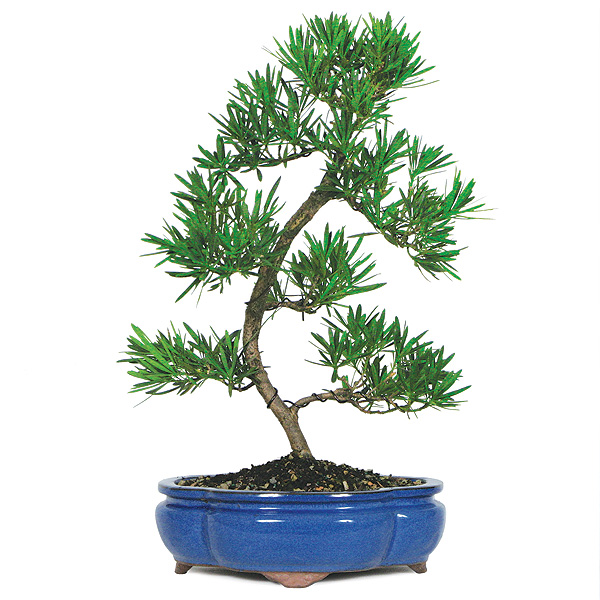
General Background:
Called the “Pine of the Buddhists”, this Chinese native bears green or purple fruit. Old Podocarpus bonsai are impressive with their stately elegance. Although trunk and bark formation will take quite a few years, Podocarpus growth varies with climate – slow-growing indoors and towards the cooler end of their range, fast-growing in sunny areas. In the wild, it can grow up to 40 ft tall.
Tree Features:
Podocarpus is a dense evergreen with pointed, leathery, dark green leaves arranged on stiff, symmetrical branches. The tree, which is self pollinating, has male flowers in cones and female flowers composed of cylindrical thickened scales. The fruits are fleshy and brightly colored. New needles start in a light green color that turns darker with age.
Temperature:
Will survive light frost, but for best results, keep above 55F. Podocarpus can be grown successfully indoors in a well-lit spot. Prefers winter temperatures between 61-68F. Like most conifers, it has a tendency to dry out without proper humidity, and will prefer being kept away from dry heat. .
Lighting:
Likes direct sunlight. Podocarpus can be kept indoors at a bright window, though it will also tolerate darker conditions. Too little light will result in large, elongated needles. In very sun-intense areas, Podocarpus may suffer leaf-burn if not given shade during the hottest part of the day.
Watering:
Likes slightly moist soil, as its root ball must not be allowed to dry out, but be sure to provide adequate drainage. The small leathery leaves of the Podocarpus will not lose much water from transpiration which makes it important to avoid overwatering this plant; Gray needles and root rot are a sign of overwatering. Increase humidity with misting and a humidity tray; these shallow trays are filled with small stones and have water in the bottom of the tray. Make sure the water does not reach the bottom of the Bonsai pot to prevent root rot. As the water evaporates, it creates an appropriate level of humidity mimicking the Podocarpus’s natural environment.
Fertilizing:
Podocarpus thrives when given fish emulsion and fertilizer cakes. For indoor growers who can’t take the fishy smell, liquid bonsai fertilizer can be used; apply every two weeks in warm weather, every six in winter. Podocarpus likes slightly acid soil with enough magnesium and iron; apply a dose of chelated iron twice yearly. To prevent magnesium deficiency, use 2-3 applications of Epsom salts (1 tbs per gallon of water) a year.
Pruning / Training:
Podocarpus plants tend to grow straight up, with no side branching. This can be remedied by cutting them back hard, which will result in aggressive back budding. Pinch back new growth as necessary, and remove oversized needles. If half of the bud is pinched away, back budding is stimulated, and leaf reduction will occur. Cutting the leaves will result only in brown edges and smaller replacement leaves will not necessarily form. Wire lignified wood for 2-3 months, being careful to watch for any signs that the wire is beginning to cut into the bark and green wood may be wired loosely. Try not to trap any needles under the wires and take care not to break old Podocarpus wood because it becomes very rigid as it ages and will be difficult to bend. Podocarpus is suitable for all sizes of bonsai, and all styles except broom. Driftwood can be beautifully incorporated into its design adding to its uniqueness and appeal.
Insects / Pests:
Scale, mealy bugs and sooty mold are pests that the Podocarpus can be susceptible to. Most types of insect infestations can be controlled with a harmless solution of 1 tsp dish soap to 1 quart lukewarm water; Spray the entire plant down with mixture to create run-off, repeat as needed.
Propagation:
Podocarpus will grow roots easily from cuttings. The best method seems to be simply to place softwood (preferably new growth) cuttings in water until roots form, and then transplant them into a quality bonsai soil with good drainage. Hardwood cuttings require the use of rooting hormone and bottom heat. Podocarpus can be grown from seed, but seeds can be hard to obtain.
Repotting:
Repot your Podocarpus every 3-4 years in spring. Roots should only be pruned by 10-15%, and only if the roots have become very dense.
Additional Comments:
Keeping a bonsai in your living environment helps clean the air and brings life and beauty into any space. Bonsai, like people and animals, are sensitive to the effects of second hand smoke and will be healthier in a smoke free environment.
DISCLAIMER: The content provided in this article is not warranted or guaranteed by Bonsai Outlet. The content provided is intended for entertainment and/or educational purposes in order to introduce to the reader key ideas, concepts, and/or product reviews. We are not liable for any negative consequences that may result from implementing any information covered in our articles or tutorials. Happy bonsai gardening.


